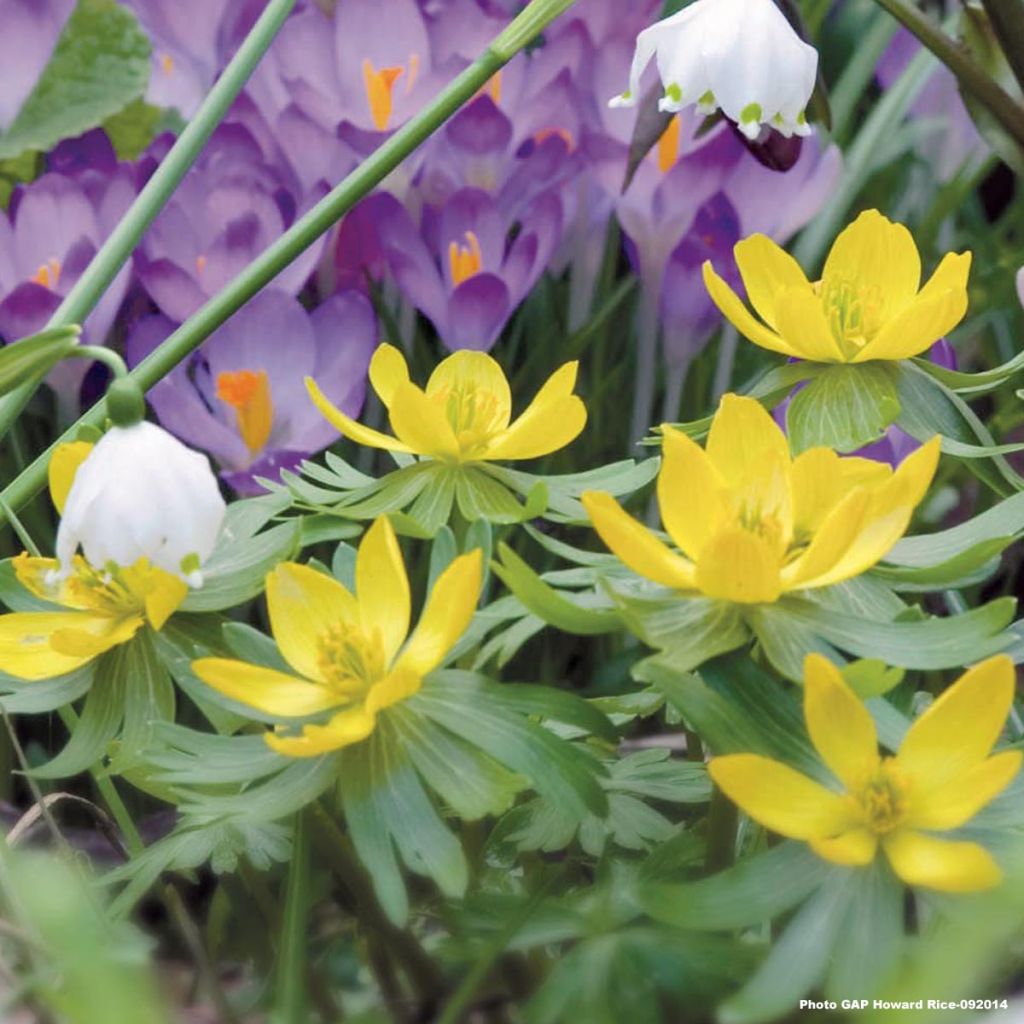

Eranthis cilicica - Aconit d'hiver
Eranthis cilicica
Eranthis cilicica
Winter Aconite
Only 2 shoots grew out of 15!! I want to point out that they were delivered cut in half! I don't think this is right. I do not recommend!
Nathalie , 15/05/2024
This plant carries a 6 months recovery warranty
More information
We guarantee the quality of our plants for a full growing cycle, and will replace at our expense any plant that fails to recover under normal climatic and planting conditions.
From €5.90 for pickup delivery and €6.90 for home delivery
Express home delivery from €8.90.
Does this plant fit my garden?
Set up your Plantfit profile →
Description
Eranthis cilicica, also known as winter aconite, yellow helloborine or winter eranthe, is a small bulbous plant that flowers in late winter or early spring. Its buttercup-like yellow flowers sometimes pierce through the snow as early as the end of January. It brings a burst of sunshine to short winter days. Its bright green, laciniate foliage tinged with bronze forms a collar at the base of the flower. Discreet throughout the rest of the year until it disappears in summer, it would be wise to mark its location in the garden. It should be planted in moist soils, under the cover of deciduous trees and bushes. Alternatively, plant it in pots.
Eranthis cilicica is a spreading perennial bulbous plant that forms a small ground cover. It belongs to the Ranunculaceae family and is native to the Middle East (Turkey, Syria, Afghanistan), where it grows on open slopes in pine forests. The plant reaches a height of 10cm (4in) and spreads up to 20cm (8in) or more under favourable conditions. It flowers from late January to March, depending on the variable climatic conditions from year to year. The bright yellow flowers, with a diameter of 3cm (1in), closely resemble buttercups. They are supported by a short stem emerging from a crown of small, palmate, and lustrous green leaves washed with bronze. The foliage is deciduous. The round and flat bulbs resemble tiny tubers of begonias.
Winter aconite should be planted in an open area on the edge of a flower bed to be able to see it up close. It works well under the cover of deciduous shrubs that flower at the same time, such as fragrant honeysuckle, witch hazel, Rhododendron praecox, and winter honeysuckle. It happily accompanies other small bulbs such as snowdrops, crocuses, daffodils, and wood anemones, as well as perennials like hellebores, winter heathers, and lungworts. It can also be used in container plantings, combined with snowdrops, hyacinths, botanical tulips, and ipheions.
The flowers should not be picked, as it only blooms in the garden. All parts of the plant are toxic if ingested, and the sap can irritate the skin.
Report an error about the product description
Plant habit
Flowering
Foliage
Safety measures
Botanical data
Eranthis
cilicica
Ranunculaceae
Winter Aconite
Middle East
ingestion
Cette plante est toxique si elle est ingérée volontairement ou involontairement.
Ne la plantez pas là où de jeunes enfants peuvent évoluer, et lavez-vous les mains après l'avoir manipulée.
Pensez à conserver l'étiquette de la plante, à la photographier ou à noter son nom, afin de faciliter le travail des professionnels de santé.
Davantage d'informations sur https://plantes-risque.info
Other Dwarf spring bulbs
Planting and care
Plant in fertile, humus-rich, moist but well-drained soil that does not dry out in summer. This plant particularly appreciates alkaline soils. It can be planted in full sun where the flowers will open fully. Alternatively, it can be planted in light shade. After flowering, the plant forms seeds. If the bulbs are happy, it can easily self-seed and become invasive. After producing its seeds in May, the aboveground part completely disappears. The clumps can be divided just after flowering. Planting can be done in autumn, burying the non-dry bulbs 5cm (2in) deep and 5cm (2in) apart. Like snowdrops, it is preferable to plant them with their leaves, just after flowering. This small bulbous plant requires no special maintenance.
Planting period
Intended location
Care
-
, onOrder confirmed
Reply from on Promesse de fleurs
Small Spring Bulbs
Haven't found what you were looking for?
Hardiness is the lowest winter temperature a plant can endure without suffering serious damage or even dying. However, hardiness is affected by location (a sheltered area, such as a patio), protection (winter cover) and soil type (hardiness is improved by well-drained soil).

Photo Sharing Terms & Conditions
In order to encourage gardeners to interact and share their experiences, Promesse de fleurs offers various media enabling content to be uploaded onto its Site - in particular via the ‘Photo sharing’ module.
The User agrees to refrain from:
- Posting any content that is illegal, prejudicial, insulting, racist, inciteful to hatred, revisionist, contrary to public decency, that infringes on privacy or on the privacy rights of third parties, in particular the publicity rights of persons and goods, intellectual property rights, or the right to privacy.
- Submitting content on behalf of a third party;
- Impersonate the identity of a third party and/or publish any personal information about a third party;
In general, the User undertakes to refrain from any unethical behaviour.
All Content (in particular text, comments, files, images, photos, videos, creative works, etc.), which may be subject to property or intellectual property rights, image or other private rights, shall remain the property of the User, subject to the limited rights granted by the terms of the licence granted by Promesse de fleurs as stated below. Users are at liberty to publish or not to publish such Content on the Site, notably via the ‘Photo Sharing’ facility, and accept that this Content shall be made public and freely accessible, notably on the Internet.
Users further acknowledge, undertake to have ,and guarantee that they hold all necessary rights and permissions to publish such material on the Site, in particular with regard to the legislation in force pertaining to any privacy, property, intellectual property, image, or contractual rights, or rights of any other nature. By publishing such Content on the Site, Users acknowledge accepting full liability as publishers of the Content within the meaning of the law, and grant Promesse de fleurs, free of charge, an inclusive, worldwide licence for the said Content for the entire duration of its publication, including all reproduction, representation, up/downloading, displaying, performing, transmission, and storage rights.
Users also grant permission for their name to be linked to the Content and accept that this link may not always be made available.
By engaging in posting material, Users consent to their Content becoming automatically accessible on the Internet, in particular on other sites and/or blogs and/or web pages of the Promesse de fleurs site, including in particular social pages and the Promesse de fleurs catalogue.
Users may secure the removal of entrusted content free of charge by issuing a simple request via our contact form.
The flowering period indicated on our website applies to countries and regions located in USDA zone 8 (France, the United Kingdom, Ireland, the Netherlands, etc.)
It will vary according to where you live:
- In zones 9 to 10 (Italy, Spain, Greece, etc.), flowering will occur about 2 to 4 weeks earlier.
- In zones 6 to 7 (Germany, Poland, Slovenia, and lower mountainous regions), flowering will be delayed by 2 to 3 weeks.
- In zone 5 (Central Europe, Scandinavia), blooming will be delayed by 3 to 5 weeks.
In temperate climates, pruning of spring-flowering shrubs (forsythia, spireas, etc.) should be done just after flowering.
Pruning of summer-flowering shrubs (Indian Lilac, Perovskia, etc.) can be done in winter or spring.
In cold regions as well as with frost-sensitive plants, avoid pruning too early when severe frosts may still occur.
The planting period indicated on our website applies to countries and regions located in USDA zone 8 (France, United Kingdom, Ireland, Netherlands).
It will vary according to where you live:
- In Mediterranean zones (Marseille, Madrid, Milan, etc.), autumn and winter are the best planting periods.
- In continental zones (Strasbourg, Munich, Vienna, etc.), delay planting by 2 to 3 weeks in spring and bring it forward by 2 to 4 weeks in autumn.
- In mountainous regions (the Alps, Pyrenees, Carpathians, etc.), it is best to plant in late spring (May-June) or late summer (August-September).
The harvesting period indicated on our website applies to countries and regions in USDA zone 8 (France, England, Ireland, the Netherlands).
In colder areas (Scandinavia, Poland, Austria...) fruit and vegetable harvests are likely to be delayed by 3-4 weeks.
In warmer areas (Italy, Spain, Greece, etc.), harvesting will probably take place earlier, depending on weather conditions.
The sowing periods indicated on our website apply to countries and regions within USDA Zone 8 (France, UK, Ireland, Netherlands).
In colder areas (Scandinavia, Poland, Austria...), delay any outdoor sowing by 3-4 weeks, or sow under glass.
In warmer climes (Italy, Spain, Greece, etc.), bring outdoor sowing forward by a few weeks.














































